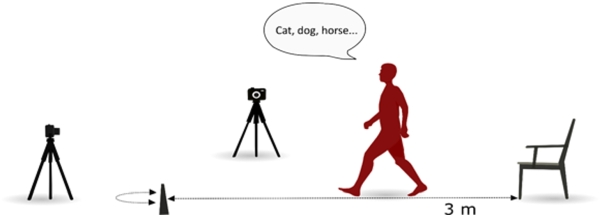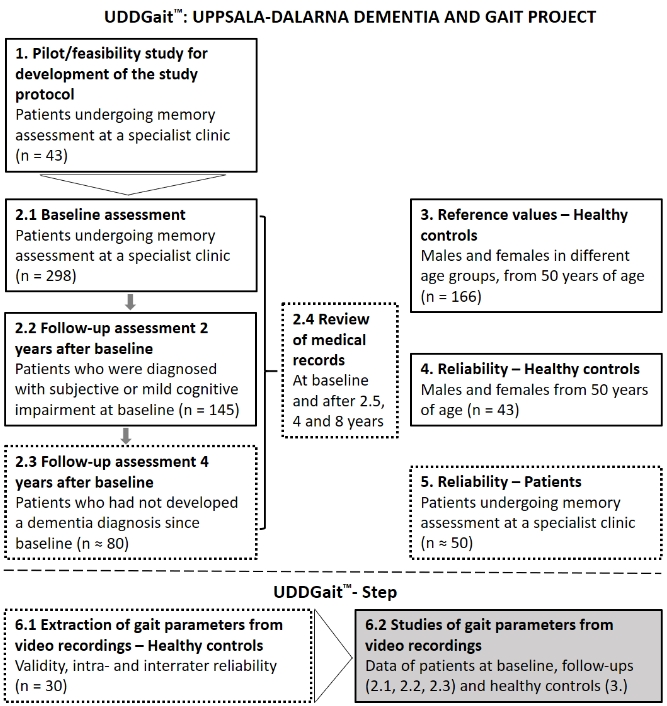Starting points
According to the World Health Organization, dementia disease is one of the fastest growing threats to public health in the world. Early identification of dementia is pointed out as a prioritized public health goal. Early diagnosis is crucial for the possibility to introduce effective interventions, which can improve quality of life for individuals with dementia and their relatives. Currently a simple and cost-effective way for early identification of cognitive impairment and dementia disease is missing. We are therefore investigating a new concept for this purpose, ”dual-task-test”, which in our studies implies the combination of a well-established mobility test (Timed Up-and-Go, TUG) with a simultaneous verbal task (i.e. TUG dual-task, TUGdt). This type of test has been judged as a potential aid for early identification of dementia disease. More research is needed to further examine the test’s validity and predictive capacity.
The overall aim is to investigate if TUGdt is useful as an aid for prediction of dementia disease. To ensure the results, the aim is also to evaluate the test’s measurement properties and to generate normative reference values of healthy control persons.
Approach
We use the TUG, which is an uncomplicated and quickly administrated test of a one movement sequence starting from a sitting position in an armchair, standing up and walking 3 meters, turning around, walking back to the chair and sitting down again. For TUGdt, TUG is combined with a verbal task of e.g. naming different animals (Fig. 1).

This type of dual-task requires divided attention, which affects persons with dementia more than healthy persons in the same age-group. For example, gait disturbances caused by dual-tasking have been shown early in the course of dementia development. Thus, TUGdt can constitute a useful clinical tool for diagnosis and treatment planning for individuals with cognitive difficulties.
Execution
A pilot study was initially carried out to develop the methodology and the study protocol. In the next step the TUGdt was utilized for base line investigations of persons attending a specialist clinic at the Akademiska hospital in Uppsala or the hospital Falu Lasarett in Falun. Those patients who at baseline went through a lumbar puncture for investigation of biomarkers of Alzheimer’s disease in spinal fluid were additionally included in a study on the correlation between these markers and TUGdt parameters. Longitudinal follow-ups of the baseline investigations have been performed and are ongoing in several steps. We have additionally included and tested healthy controls by TUGdt to generate reference values and evaluate the test-retest reliability - see Figure 2 and the list of publications below. Data collection for evaluation of test-retest reliability for patients undergoing memory assessments is ongoing. We have additionally developed a side project focused on analysis of gait parameters extracted from video recordings of TUG and TUGdt.

UDDGait™: Uppsala-Dalarna Dementia and Gait Project
1. Pilot/feasibility study for development of the study protocol (data collection finished)
Patients undergoing memory assessment at a specialist clinic (n = 43)
2.1 Baseline assessment (data collection is finished)
Patients undergoing memory assessment at a specialist clinic (n = 298)
2.2 Follow-up assessment 2 years after baseline (data collection finished)
Patients who were diagnosed with subjective or mild cognitive impairment at baseline (n = 145)
2.3 Follow-up assessment 4 years after baseline (data collection ongoing)
Patients who had not developed a dementia diagnosis since baseline (n ≈ 80)
2.4 Review of medical records (data collection ongoing)
At baseline and after 2.5, 4 and 8 years
3. Reference values – Healthy controls (data collection finished)
Males and females from 50 years of age (n = 166)
4. Reliability – Healthy controls (data collection finished)
Males and females from 50 years of age (n = 43)
5. Reliability – Patients (data collection ongoing)
Patients undergoing memory assessment at a specialist clinic (n ≈ 50)
UDDGait™ - Step
6.1 Extraction of gait parameters from video recordings – Healthy controls (data collection ongoing)
Validity, intra- and interrater reliability (n = 30)
6.2 Studies of gait parameters from video recordings (data preparation planned)
Data of patients at baseline, follow-ups (2.1, 2.2, 2.3) and healthy controls (3.)
Figure 2. Overview of data collection and research participants in UDDGait™ and UDDGait™-Step. Boxes framed with a solid line indicate completed data collection, those with a dotted line indicate ongoing data collection and grey box planned data preparation.
For this purpose, we have collected data at the Biomechanics and Motor Control laboratory (BMC) at the Swedish School of Sport and Health Sciences (GIH), Stockholm to evaluate the measurement properties for the use of video recordings in the evaluation of TUGdt step gait parameters. We have developed and used specific methodology for semi-automated extraction of gait parameters from video.
The Research Group and Cooperation
Professor Anna Cristina Åberg leads the UDDGait™, which is built on cooperation among researchers at Dalarna University (DU), Uppsala University (UU), Umeå University (UmU) and the Tecnologico de Monterrey, Campus Estado de Mexico, Mexico (TdM).
The group possesses strong expertise in the areas of physiotherapy, gerontology, dementia disease, biomechanics, movement analysis, and biostatistics. Anna Cristina Åberg (DU and UU) is the principal investigator, cooperating with: professor Erik Rosendahl (UmU), professor Kevin McKee (DU), ass. professor Kjartan Halvorsen (TdM and UU), ass. professor Lars Berglund (DU and UU), professor Martin Ingelsson (UU), professor Lena Kilander (UU), MD Vilmantas Giedraitis (UU), MD Ylva Cedervall (UU) and PhD student Hanna Bozkurt Åhman (UU).
In the UDDGait™-Step we additionally cooperate with PhD Fredrik Olsson (the Royal Institute of Technology), professor Toni Arndt (GIH), laboratory engineer Olga Tarassova (GIH), MSc Wei Peng (UU) and MSc Isabell Ahlström (UU).
Funding
Financial support has been received from the Swedish Research Council, the Promobilia Foundation, the Dementia Foundation, UU Innovation, the Geriatric Foundation, the Alzheimer Foundation Sweden, the Uppsala-Örebro Regional Research Council, the County Council of Uppsala, the Swedish Society of Medicine, and the Commemorative Foundation of Ragnhild and Einar Lundström.